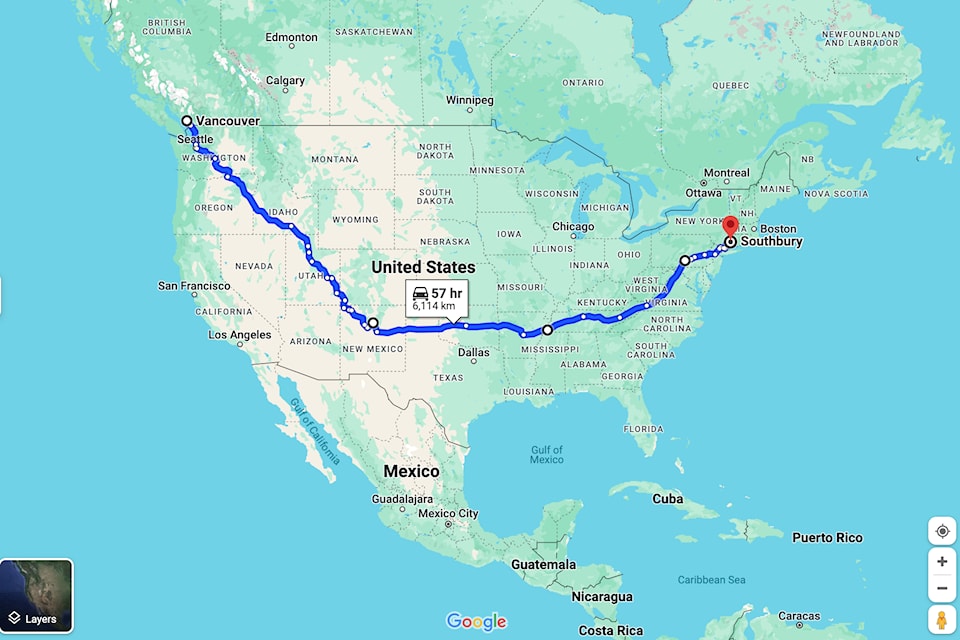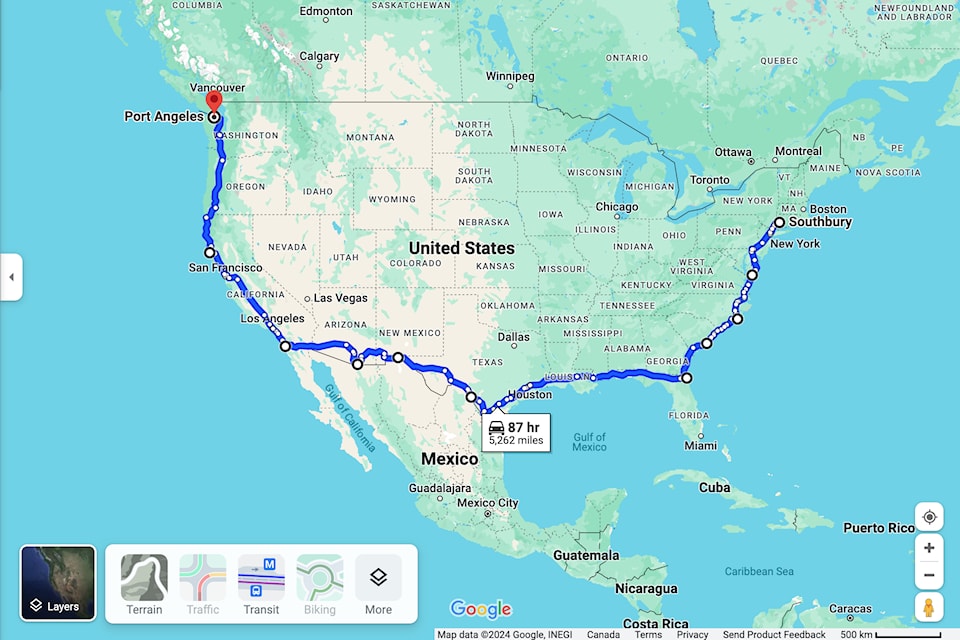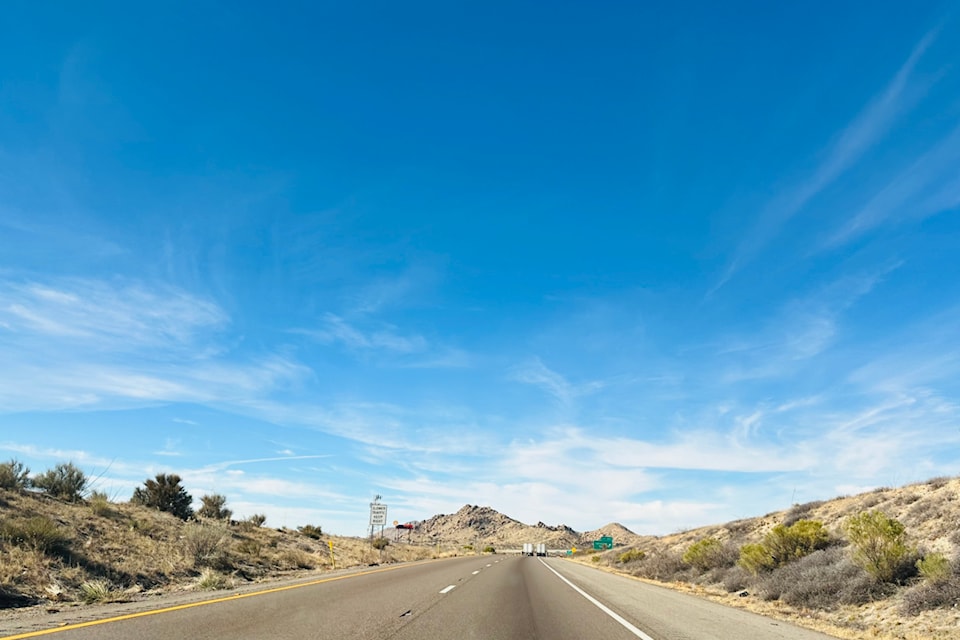Two adults, aged 58 and 63. One four-year-old, 20-pound dog. An older-version Honda CR-V. Twenty-nine states. Fifteen thousand kilometres. One new starter; four new tires.
Last November, my husband, Bruce, our dog, Zorro, and I took off from the West Coast of Canada and over the next nine days cut across Washington, Oregon, Idaho and Utah to Santa Fe in New Mexico, where we turned and headed east. The Texas panhandle, Oklahoma, Arkansas, Tennessee, Washington, DC, Virginia, New York...Eventually, we landed in Connecticut, where our daughter had recently birthed our first grandchild.
Three months later, now February, we headed home, giving ourselves two weeks and averaging six hours of driving per day. Hugging the US coast, we drove through Virginia, North and South Carolina, Georgia, Florida, Alabama, Mississippi and Louisiana, and then followed the US/Mexican border through Texas, New Mexico, Arizona and California.
It was an epic adventure.
Road trips have always been our happy place, and this was no exception. In a perfect world, we would have had more time to experience the flavours of each destination; as it was, the trip served up an appetizer tray. There were a lot of spots – Savannah, San Antonio, Santa Fe – where, hopefully, we can return one day to experience the full-meal deal.
But in the meantime, we learned a lot about preparing for a road trip and living on the road. So, here are our some of our survival tips.
Choosing the wheels
We explored ideas around taking our ‘78 VW van or our ’03 Delica, or selling both and buying a newer, more reliable RV. We also looked at a conversion kit that transforms an SUV into a sleeping unit and considered mixing camping with hotel stays. But adding up fuel economy, comfort and easy-to-access car parts should a breakdown occur, we ultimately decided to take our trusty CR-V.

Prepping the wheels
We put a lot of thought into car organization and purchased several items.
• We invested in a cushy, dog-specific car seat for Zorro. It attached to the backseat and to his harness, giving him a comfortable spot for spending hours in the car and keeping him safer should an accident occur.
• We bought a travel tray that sat between us just below the dashboard. Attached to one of the console’s cupholders, it gave us a total of three cupholders instead of two and provided a useful area to put things as we drove: snacks, phones, keys, coins….
• Rest stops are great – stop when you see one! But a lot of the time on the road there is simply no place to pee, and that is when your hand-held unisex urinal becomes the most beloved item in your vehicle.
• Trail mix in the glove box. On the road, you spend a lot of time hungry, often with few dining options. We travelled with a small cooler for Zorro’s food and a few canned drinks, plus a bag in the backseat of the car with additional snacks. But what we dove into most often was that trail mix in the glove box.
Overnights
Our initial plan was to go economy level on the hotels – after all, we’d be arriving in the early evening and leaving in the early morning. But after our first night in a motel that had thin walls and questionable bedding, we upgraded that plan. We also discovered what is probably obvious; better hotel deals are found in smaller areas outside urban centres.
We booked through a third-party app because it was super easy to use, filtered out non-pet-friendly hotels, gave us essential information and reviews, and rewarded us with a couple of free stays. (However, there are risks booking with third-party apps; for example, when I booked a hotel for the wrong night, I was unable to get a refund.) We looked for pet-friendly hotels with fridges and free parking, often choosing suites with kitchens. We loved the Home2 Suites by Hilton line, although the pet fee was sometimes hefty.
Most of the hotels we selected early in the trip had a pet fee of around US$25, so we were shocked to walk into a Sonesta Royal in Nashville and fork over US$100 for Zorro. It turned out that the US$25 pet fees were the exception, not the norm, and it became essential when booking hotels to check the pet fee in advance. Some hotel can charge up to US$150 for a pet – sometimes close to the price of the hotel room itself.
Here's another hotel hot tip: if you are using a cooler and your hotel room doesn’t have a freezer compartment in the fridge, use the ice machine to keep your cooler cool.

Gastronomy
As usually happens with us on the road, we quickly settled into a routine of eating breakfast, a midday snack and a larger, late-afternoon or early-evening meal. The biggest tip here is: American restaurants serve up huge portions, so we helped our budget by ordering one entree to share, or a main and a side dish – and always had enough food for the two of us.
Travelling with a dog complicates eating out. Breweries, we discovered, are the best place to find pet-friendly dining and in warmer climes, of course, pet-friendly patios abound.
Fuelling up
We stopped for gas at least once a day. Often, when paying for gas with a credit card in the US, you’ll be asked to enter a ZIP code – creating a conundrum for Canadian travellers. To solve this, enter the three numerical digits contained in your postal code followed by two zeros. (So, our postal became 82200.) It took us a few stops to learn this, so another hot tip is to carry cash. Our credit cards didn’t always work, and my debit card rarely worked, so we used a lot of cash.
Getting cash out of a bank machine? Look for Toronto Dominion or Wells Fargo, as a lot of other banks are hit and miss for accessing funds with Canadian debit cards
Navigation
Bruce, bless his heart (as they say in the deep south), loves his maps, and at the start of the trip he spent considerable time looking at the maze of highways in our map book, trying to remember exit numbers, while I basically rolled my eyes and opened the Maps app on my phone.
We were really impressed with the US highway system. You could get anywhere you wanted with about 10 route options. But when it comes to exiting one highway for another highway again and again, there is nothing like having Siri guide you through it. We used the Maps app on our iPhones, which kept distance prompts in kilometres, leading to more instinctual timing estimations.
Our friend Siri also let us know if there were road condition issues (accidents, flooding, debris on the road), offering to change our route on the fly, and alerted us to speed traps.
Ultimately, road trips benefit from what I consider the four cornerstones of happy travel: forethought, flexibility, spontaneity and acceptance. Be thorough in your planning but prepare to change it on the fly and accept that things might go differently than anticipated.
But there’s nothing quite like being on the road, and we can’t wait to pack up the car again and hit the highway for further adventures.
This story appeared in the Fall issue of Boulevard Vancouver.



